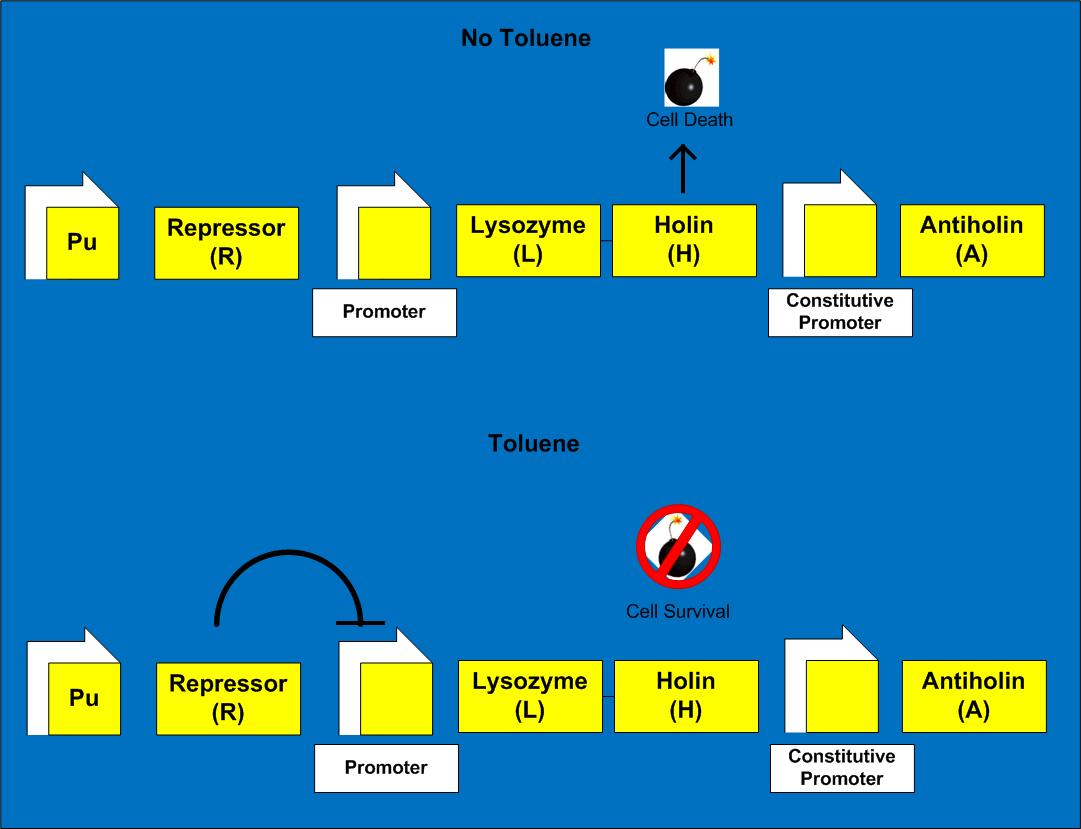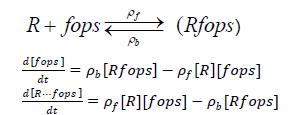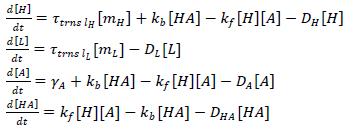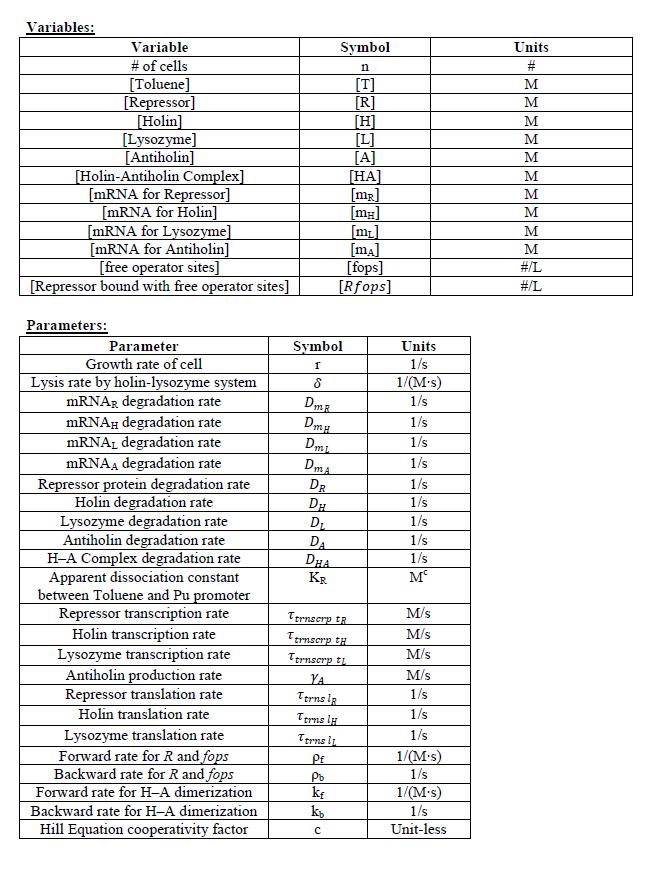Team:Michigan/Modeling
From 2009.igem.org
Charlieyan (Talk | contribs) |
|||
| (26 intermediate revisions not shown) | |||
| Line 1: | Line 1: | ||
{{Michigan Header}} | {{Michigan Header}} | ||
| - | [[Image: | + | {|class="wikitable" border="0" cellpadding="10" cellspacing="1" style="padding: 1px; background-color:dodgerblue; border: 1px solid mediumblue; text-align:center" |
| + | !width="20%" align="left" valign="top" style="background:gold; color:black"| | ||
| + | <font color=navy> | ||
| + | |||
| + | = <font color=royalblue size=6>The Toluene Terminator Model</font> = | ||
| + | |||
| + | ==<B><font size=3>Overview</font></B> : == | ||
| + | The following mathematical model examines the dynamics of the Suicide Mechanism with Tunable Repression (see Project Page). As outlined in the project description, the Pu promoter is placed in front of a repressor system that would inhibit the production of holin and lysozyme, while a constitutive promoter is placed in front of the gene for antiholin. In the presence of toluene, the Pu promoter would be activated, leading to repression of holin/lysozyme production and therefore cell survival. In the absence of toluene, the Pu promoter would not be activated, and as a result holin and lysozyme would be produced, leading to cell death. | ||
| + | |||
| + | [[Image:Kill_switch_topology_for_modeling.jpg|950px]] | ||
| + | |||
| + | |||
| + | ==<B><font size=3>Cell Growth/Death</font></B> == | ||
| + | * Cell Lysis happens when holin creates pores in the cell membrane, allowing lysozyme to attack the cell wall. | ||
| + | |||
| + | * Assuming rate of cell death is proportional to [holin](# cells), rate of cell growth in exponential phase is: | ||
| + | |||
| + | [[Image:Equation1.jpg]] | ||
| + | |||
| + | ==<B><font size=3>Transcription of Repressor</font></B> : == | ||
| + | |||
| + | [[Image:Equation2.jpg]] | ||
| + | |||
| + | f([T]) is a function of toluene concentration | ||
| + | |||
| + | * Use the Hill Equation to describe binding affinity of toluene to the Pu promoter: | ||
| + | |||
| + | [[Image:Equation3.jpg]] | ||
| + | |||
| + | ==<B><font size=3>Transcription of Lysozyme and Holin:</font></B>== | ||
| + | * Assume the transcription rate is proportional to the number of free operator sites (which should be the same for both lysozyme and holin, since they are downstream of the same promoter). | ||
| + | |||
| + | [[Image:Equation4.jpg]] | ||
| + | |||
| + | * Assume transcription rates for H and L are the same. | ||
| + | |||
| + | ==<B><font size=3>Repression of Lysozyme and Holin Transcription </font></B> == | ||
| + | |||
| + | * Repressor binds with free operator site, preventing transcription of lysozyme and holin. | ||
| + | * Invoking law of mass action: | ||
| + | |||
| + | [[Image:Equation5.jpg]] | ||
| + | |||
| + | Assuming that fops and Rfops do not undergo spontaneous degradation. | ||
| + | |||
| + | ==<B><font size=3>Production of Repressor </font></B> == | ||
| + | |||
| + | * Using the translation rate for R and taking into consideration the binding of R with fops: | ||
| + | |||
| + | [[Image:Equation6.jpg]] | ||
| + | |||
| + | ==<B><font size=3>Production of Proteins </font></B> == | ||
| + | |||
| + | * Production of antiholin, under constitutive promoter, is at a constant rate γA, which depends on the promoter that is used. | ||
| + | |||
| + | |||
| + | ''Dimerization:'' | ||
| + | * Since holin and antiholin form a complex-- | ||
| + | |||
| + | [[Image:Equation7.jpg]] | ||
| + | |||
| + | --and using the translation rates and incorporating dimerization using the law of mass action: | ||
| + | |||
| + | [[Image:Equation8.jpg]] | ||
| + | |||
| + | ==<B><font size=3>Assumptions</font></B> == | ||
| + | |||
| + | * We can set γA equal to rate of production of holin in the case that all operating sites are free. | ||
| + | ** This is in order to balance antiholin and holin levels without repression | ||
| + | ** ''This can be tuned so that timing of cell death works out'' | ||
| + | ** Set antiholin production rate to that of holin in the absence of repression | ||
| + | ** Put this through the transcription and translation equations to obtain production rate | ||
| + | |||
| + | |||
| + | * We assume degradation rates of all mRNAs are the same. | ||
| + | ** Can use half life to calculate rate [[Image:Equation9.jpg]] | ||
| + | |||
| + | |||
| + | For protein degradation rate: | ||
| + | |||
| + | * ''Case 1: Proteins are stable:'' | ||
| + | ** Degradation rates equal reproduction rate of cell | ||
| + | ** This is due to dilution of proteins across daughter cells | ||
| + | |||
| + | * ''Case 2: Proteins are unstable'' | ||
| + | |||
| + | |||
| + | ==<B><font size=3>Variables and Parameters</font></B> == | ||
| + | |||
| + | [[Image:Variables_and_Parameters.jpg|center]] | ||
| + | |||
| + | ==<B><font size=3>Further Work</font></B> == | ||
| + | We plan to run simulations of this model using MATLAB, focusing on the relationship between cell count and toluene concentration. Before this is done, we must find or estimate values for the parameters listed above. Initial simulations will be tailored to fine-tuning parameters to satisfy the primary needs of the modeling: at high toluene concentrations, the cells will survive; at low toluene concentrations, the cells will die. After that, we will look at low-to-high and high-to-low transitions in toluene concentrations and look for equilibria that arise as a result. This will help us understand how responsive the system is to toluene levels (including initial concentrations). | ||
| + | |||
| + | Lastly, a future version of this model will couple the kill switch mechanism with the degradation mechanism. One of the major effects that this will have on the kill switch modeling is that toluene levels will be reduced by the degradation pathway. To understand coupling effect is one of the major goals down the road, as it will help us gain a deeper understanding of the overall dynamics of our proposed project. | ||
Latest revision as of 23:59, 21 October 2009
| ||||||||||||||||||||||
|---|---|---|---|---|---|---|---|---|---|---|---|---|---|---|---|---|---|---|---|---|---|---|
|
The Toluene Terminator ModelOverview :The following mathematical model examines the dynamics of the Suicide Mechanism with Tunable Repression (see Project Page). As outlined in the project description, the Pu promoter is placed in front of a repressor system that would inhibit the production of holin and lysozyme, while a constitutive promoter is placed in front of the gene for antiholin. In the presence of toluene, the Pu promoter would be activated, leading to repression of holin/lysozyme production and therefore cell survival. In the absence of toluene, the Pu promoter would not be activated, and as a result holin and lysozyme would be produced, leading to cell death.
Cell Growth/Death
Transcription of Repressor :f([T]) is a function of toluene concentration
Transcription of Lysozyme and Holin:
Repression of Lysozyme and Holin Transcription
Assuming that fops and Rfops do not undergo spontaneous degradation. Production of Repressor
Production of Proteins
--and using the translation rates and incorporating dimerization using the law of mass action: Assumptions
Variables and ParametersFurther WorkWe plan to run simulations of this model using MATLAB, focusing on the relationship between cell count and toluene concentration. Before this is done, we must find or estimate values for the parameters listed above. Initial simulations will be tailored to fine-tuning parameters to satisfy the primary needs of the modeling: at high toluene concentrations, the cells will survive; at low toluene concentrations, the cells will die. After that, we will look at low-to-high and high-to-low transitions in toluene concentrations and look for equilibria that arise as a result. This will help us understand how responsive the system is to toluene levels (including initial concentrations). Lastly, a future version of this model will couple the kill switch mechanism with the degradation mechanism. One of the major effects that this will have on the kill switch modeling is that toluene levels will be reduced by the degradation pathway. To understand coupling effect is one of the major goals down the road, as it will help us gain a deeper understanding of the overall dynamics of our proposed project. |
|---|
 "
"





